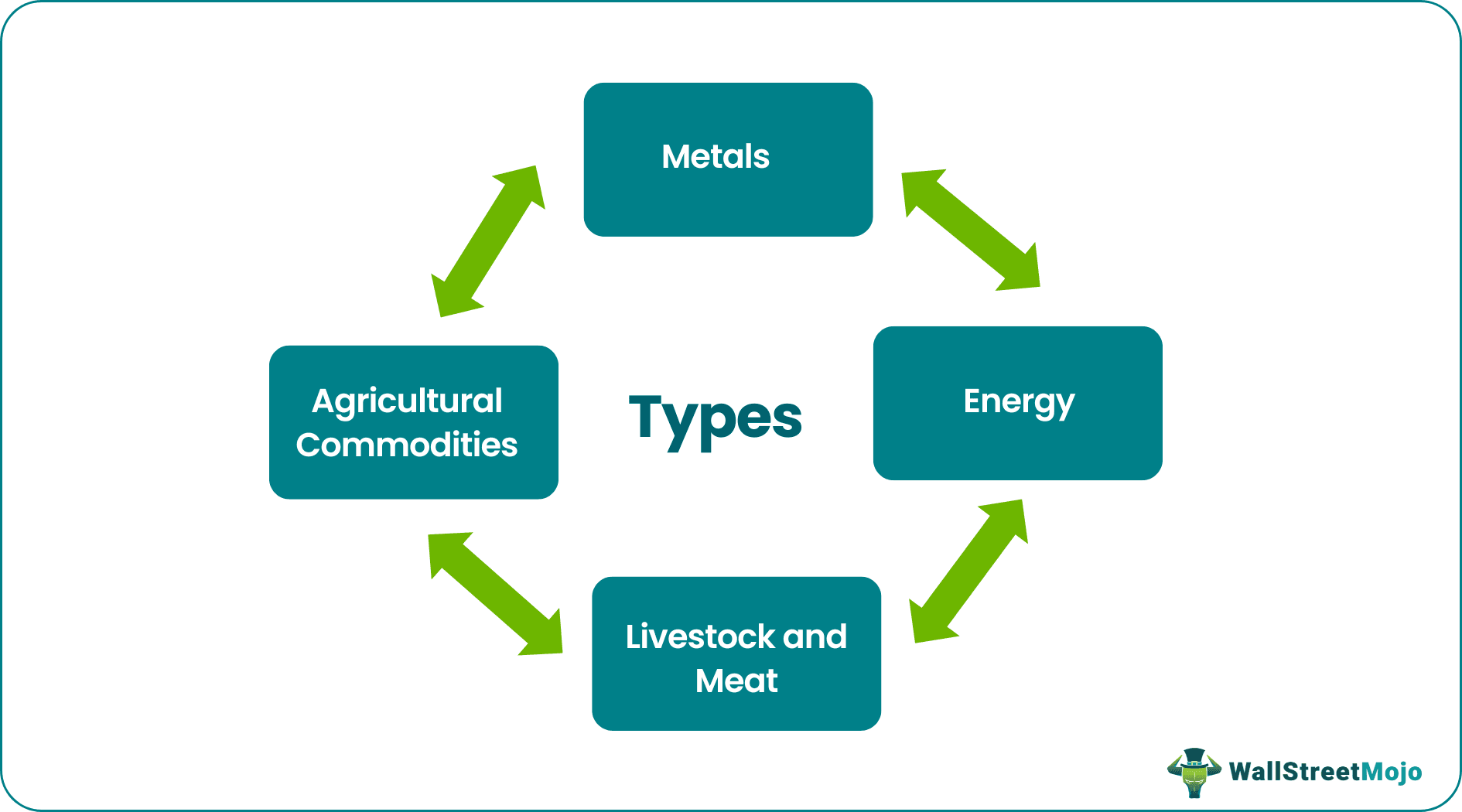Table Of Contents
Commodity Definition
The commodity is a basic commodity used in manufacturing other products and services or as a store of value, manufactured or grown by different global producers with little or no differentiation.
Types of Commodities
The following are types of commodities:

#1 - Metals
Metals are generally manufactured by processing mined ore. Steel, copper, aluminium, gold, and silver are some of the most common metallic commodities. Metals can further be classified into two categories:
- Industrial Metals - These types of metals are abundantly available and are generally used in industrial activities like the manufacturing of a huge number of products. As they are good conductors of heat and electricity, they can be found in most of the products we use daily. Copper, lead, zinc, tin, and aluminum are a few most prevalent examples of industrial metals.
- Precious Metals - These types of metals are valued higher than industrial metals because they are not abundantly available and are difficult to mine and produce. They are used for both industrial purposes and stores of value. Investors and traders buy and hold them for the safety of capital or gains.
#2 - Energy
It mainly provides fuels to run motors, appliances, and even space rockets. It plays an integral part in the overall functioning of the world. Commodities like oil, electricity, natural gas, gasoline, and ethanol are a few common examples.
#3 - Livestock and Meat
Livestock and meat are commodities that are bought for slaughter and meat consumption. The most prominent example in this category is cattle, which can be traded as live cattle (cattle mature enough to be slaughtered) and feeder cattle (cattle that should be fed and grown before they can be slaughtered).
#4 - Agricultural Commodities
These are produced by farmers and traded worldwide. The most common examples are rice, wheat, corn, and sugar.
Role of Commodities in Business and Economy
It plays an integral part in the overall functioning of the economy. Giant companies are involved in commodity trading across the world. Different countries specialize in producing different commodities based on the availability of natural resources in those countries. China is the world's largest steel manufacturer, while Chile leads in copper and Russia in aluminium. China is the world’s largest consumer of most used hard commodities due to its manufacturing boom in the past 2-3 decades.
Pricing of Commodities
Price discovery happens based on demand and supply. Supply disruptions like manufacturers' closures, natural disasters, or cartel cuts generally result in higher prices. Alternatively, an unanticipated spike in demand due to increased economic activity or for any other reason results in increased commodity prices. Similarly, price declines come from higher supply or lower demand.
Commodity exchanges play a pivotal role in their price discovery. They are freely traded worldwide in almost every country's commodity exchanges. Major exchanges across the world are the Chicago Mercantile Exchange (CME), Chicago Board of Trade (CBOT), New York Mercantile Exchange (NYMEX), and the London Metal Exchange (LME).
Commodity Trading and Investing
Several investors and traders, including giants like Dangote and Cargill, are major traders in commodity markets. The margins are quite low in commodities due to their fast-moving nature, efficient price discovery, and low entry barriers.
Derivatives are generally used for hedging purposes, and the actual delivery takes place for trades that manufacturers enter. These players hedge their price exposure through derivative contracts. Traders and investors can also take exposure through the spot market (cash) or derivatives market trading in futures and options.
Another breed of traders is speculators who buy or sell contracts in anticipation of future higher or lower prices. Its price speculation is widely practiced, and speculators hardly take or deliver physical commodities.
Regulations in the Commodity Market
There are no regulations when two parties join hands privately to trade commodities; however, if the trades happen through exchanges, those trades are governed by regulatory agencies like the Commodity Futures Trading Commission (CFTC) in the United States Markets in Financial Instruments Directive (MiFID) in Europe.
The regulatory agencies try to limit the speculative activity to avoid unnecessary bubbles formed by the few players' vested interests.
Commodity Cycles
Commodities go through cycles every once in a while when their prices increase significantly (generally in an economic bull run), reach unsustainable levels, and then decline subsequently to remain in a slump for some time. All commodities (especially metals) can display this behavior simultaneously, but there could also be instances of individual commodities seeing a cycle at different times.
Advantages
Some of the advantages are as follows:
- It plays a pivotal role in the overall functioning of the economy. Nearly everything that we use or eat today uses commodities.
- These are a hedge against inflation; their price tends to increase at the rate of inflation.
- This sector is a huge job creator and employs millions of people across the globe.
Disadvantages
Some of the disadvantages are as follows:
- The most pressing problem that it causes is pollution. Coal is said to be the most polluting commodity.
- Mining ore sometimes comes at the cost of decimating forests and wildlife.
- The working conditions of people in commodity manufacturing/handling in the developing world are said not to be up to the mark.
- These are prone to speculation, which leads to the formation of bubbles and subsequent bursts, which also hurts the genuine players in the market.
Conclusion
Commodities have been around for centuries, and the world has evolved significantly. The market has also evolved, and with trade and commerce, commodities travel easily from one part of the world for use in other parts of the world. Agencies across the world are trying to figure out how we can use less of some polluting commodities and replace them with not-so-polluting materials for environmental sustainability.
There is no doubt that commodities have played an important part in shaping humanity and economies, and they will continue to do so in the future.

